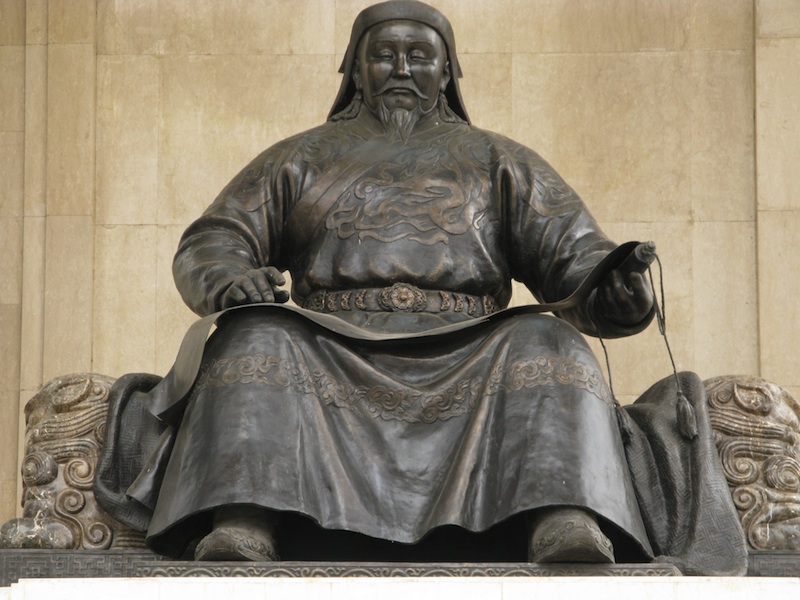Mongol Invasion in 1200 Altered Carbon Dioxide Levels

The Mongol invasion of Asia in the 1200s took enough carbon dioxide out of the atmosphere to offset a year's worth of the world's gasoline demand today, according to a new study. But even Genghis Khan couldn't create more than a blip in atmospheric carbon compared to the overwhelming effect of agriculture.
The study, published online Jan. 20 in the journal The Holocene, looked at land use and carbon dioxide in the atmosphere between the years 800 and 1850. Globally at the time, humans were cutting down forests for agriculture, driving carbon into the atmosphere (vegetation stores carbon, so trees and shrubs are what scientists call "carbon sinks"). But in some regions during certain times, wars and plagues culled the population, disrupting agriculture and allowing forests to regrow.
The question, said Julia Pongratz, a postdoctoral researcher at the Carnegie Institution's Department for Global Ecology at Stanford University, was whether this regrowth could have locked up enough carbon to make a difference in global atmospheric carbon dioxide.
"We wanted to check if humans had an impact on carbon dioxide by increasing it by deforestation, but also by decreasing it," Pongratz told LiveScience.
Catastrophes and carbon
Pongratz and her colleagues used a detailed reconstruction of historical agriculture to model the effect of four major wars and plagues in the 800 to 1850 time period: the Mongol takeover of Asia (from about 1200 to 1380), the Black Death in Europe (1347 to 1400), the conquest of the Americas (1519 to 1700) and the fall of the Ming Dynasty in China (1600 to 1650).
All of these events led to death on a massive scale (the Black Death alone is thought to have killed 25 million people in Europe). But Mother Nature barely noticed, the researchers found. Only the Mongol invasion had a noticeable impact, decreasing global carbon dioxide by less than 0.1 part per million. This small amount required that the forests absorb about 700 million tons of carbon dioxide, which is the amount emitted annually by worldwide gasoline demand today. But it was still a very minor effect, Pongratz said.
Sign up for the Live Science daily newsletter now
Get the world’s most fascinating discoveries delivered straight to your inbox.
"Since the pre-industrial era, we have increased atmospheric CO2 [or carbon dioxide] concentration by about 100 parts per million, so this is really a different dimension," she said.
The effect of all of the events was small or nonexistent for a few reasons, Pongratz said. For one, disasters such as the Black Plague or the fall of the Ming Dynasty are too short to allow for full forest regrowth. It can take a century or more for a tree to get to its full carbon storage capacity, Pongratz said, and populations were recovering by then. Plus, rotting roots and felled vegetation continued to release carbon into the atmosphere for decades as the fields lay fallow.
Another factor was that while one part of the world burned, the rest planted. In the case of the conquest of the Americas in particular, Pongratz said, native people with a minimal agricultural footprint were dying, while deforestation continued across the globe.
The role of agriculture
Studies of Antarctic ice cores suggest that carbon dioxide dropped much more during these eras than the models by Pongratz and her team revealed. That may mean that natural factors, such as changes in solar radiation, played a larger role in atmospheric carbon dioxide than reforestation during this time, Pongratz said.
But agriculture's proportional role isn't certain yet. The researchers may have underestimated the effect of forest regrowth, said Richard Nevle, an instructor at Bellarmine College Preparatory in San Jose who has investigated environmental change surrounding the conquest of the Americas. Some of the team's assumptions about the amount of carbon released from rotting vegetation in the soil were more conservative than necessary, Nevle (who was not involved in the study) told LiveScience. Nonetheless, he said, the study provides a "new, sophisticated tool" to advance the understanding of climate change in the pre-industrial era.
"I think it will eventually help us nail down a more definitive answer to the mystery of the large drop in atmospheric CO2 concentration that occurred during the 16th and 18th centuries," Nevle said. "I look forward to seeing this work evolve."
You can follow LiveScience Senior Writer Stephanie Pappas on Twitter @sipappas.

Stephanie Pappas is a contributing writer for Live Science, covering topics ranging from geoscience to archaeology to the human brain and behavior. She was previously a senior writer for Live Science but is now a freelancer based in Denver, Colorado, and regularly contributes to Scientific American and The Monitor, the monthly magazine of the American Psychological Association. Stephanie received a bachelor's degree in psychology from the University of South Carolina and a graduate certificate in science communication from the University of California, Santa Cruz.









